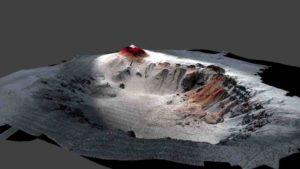
Credit: Rebecca Carey, University of Tasmania, Adam Soule, WHOI, ©Woods Hole Oceanographic Institution
On July 18, 2012, passengers on an airline flight over the Southwest Pacific Ocean glimpsed something unusual — a raft of floating rock known as pumice that indicated an underwater volcanic eruption had occurred on the seafloor northeast of New Zealand. The raft eventually grew to more than 150 square miles (roughly the size of Philadelphia), a sign that the eruption was unusually large.
A new paper published January 10, 2018, in the journal Science Advances describes the first up-close investigation of the largest underwater volcanic eruption of the past century. The international research team led by the University of Tasmania and the Woods Hole Oceanographic Institution (WHOI) used the autonomous underwater vehicle (AUV) Sentry and the remotely operated vehicle (ROV) Jason to explore, map, and collect erupted materials from the Havre volcano during a 2015 expedition. They found that the eruption was surprising in many ways.
“We knew it was a large-scale eruption, approximately equivalent to the biggest eruption we’ve seen on land in the 20th Century,” said Rebecca Carey, a volcanologist at University of Tasmania and Co-Chief Scientist on the expedition.
“Heading to the site, we were fully prepared to investigate a typical deep-sea explosive eruption,” added Adam Soule, WHOI associate scientist and chief scientist for the National Deep Submergence Facility. “When we looked at the detailed maps from the AUV, we saw all these bumps on the seafloor and I thought the vehicle’s sonar was acting up. It turned out that each bump was a giant block of pumice, some of them the size of a van. I had never seen anything like it on the seafloor.”
More than 70 percent of all volcanic activity on Earth occurs on the seafloor, but details of these events are largely hidden from view by seawater. Based on the size of the 2012 pumice raft, the eruption of the Havre Volcano was estimated to be the largest documented underwater silicic eruption — a particular type of eruption that produces viscous, gas-filled lava that often occurs explosively. Despite their violence, very little is known about silicic eruptions and most knowledge about them comes from ancient rock records, which lack details such as the timing, duration, source, and water depth of the events. Scientists have never been able to study a large underwater silicic eruption shortly after it occurred in order to better understand how they happen and what they produce.
Havre is part of the Kermadec Arc, a chain of volcanoes, some of which reach the surface to form the Kermadec Islands, between New Zealand and American Samoa. The volcanoes are formed by conditions at the subduction zone where one of Earth’s largest tectonic plates, the Pacific Plate, dives beneath the Australian Plate. New Zealand scientists mapped the Havre volcano, a caldera nearly three miles (4.5 kilometers) across on the seafloor northeast of the North Island of New Zealand, using shipboard sonar instruments in 2002 and again immediately after the eruption in 2012, revealing the presence of new volcanic material on the seafloor.
In 2015, scientists from the University of Tasmania, WHOI, the University of California Berkeley, the University of Otago in New Zealand, and others traveled to the region on board the research vessel Roger Revelle operated by the Scripps Institution of Oceanography. They deployed the AUV Sentry in a series of 11 dives that mapped more than 19 square miles (50 square kilometers) of seafloor. They also conducted 12 ROV Jason dives totaling 250 hours to collect samples of erupted material and to capture high-resolution imagery of the seafloor inside the crater.
The team found that the eruption history of the Havre volcano was much more complicated than they previously thought, with the most recent eruption alone consisting of lava from 14 volcanic vent sites between 900 and 1220 meters (3000 and 4000 feet) below the surface. They also discovered that, what they thought was initially an explosive eruption that would produce mainly pumice, also created ash, lava domes, and seafloor lava flows. Mapping and seafloor observations revealed that, of the material that erupted, which was nearly 1.5 times larger than the 1980 eruption of Mount St. Helens, about 75 percent floated to the surface and drifted away with winds and currents. The rest was spread across the seafloor up to several miles away.
“Ultimately we believe that none of the magma was erupted in the ways we assume an explosive eruption occurs on land,” said Soule.
Material collected using ROV Jason confirmed the diverse nature of the eruption, bringing samples of dense lava, ash, pumice, and giant pumice to the surface, including one piece measuring 5 feet (1.5 meters) in diameter that is the first of its kind ever collected and is currently on display at the National Museum of Science and Nature in Tokyo. The physical and chemical composition of these samples are helping scientists learn how the eruption proceeded, what made it act the way it did, and how the material changes over time.
This work was supported by a grant from the National Science Foundation.
Reference:
Rebecca Carey et al. The largest deep-ocean silicic volcanic eruption of the past century. Science Advances, 2018 DOI: 10.1126/sciadv.1701121
Note: The above post is reprinted from materials provided by Woods Hole Oceanographic Institution.









